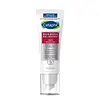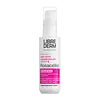What's inside
What's inside
 Key Ingredients
Key Ingredients

 Benefits
Benefits

 Concerns
Concerns

 Ingredients Side-by-side
Ingredients Side-by-side

Water
Skin ConditioningCaprylic/Capric Triglyceride
MaskingGlycerin
HumectantPropanediol
SolventPentylene Glycol
Skin ConditioningHelianthus Annuus Seed Oil
EmollientSorbitol
HumectantDimethicone
EmollientButyrospermum Parkii Butter
Skin ConditioningCetearyl Alcohol
EmollientBehenyl Alcohol
EmollientGlyceryl Stearate
EmollientSodium Hydroxide
BufferingTocopheryl Acetate
AntioxidantAllantoin
Skin ConditioningDipotassium Glycyrrhizate
HumectantSodium Hyaluronate
HumectantCeramide NP
Skin ConditioningPanthenol
Skin ConditioningCaffeine
Skin ConditioningCitric Acid
BufferingCetyl Alcohol
EmollientCeteareth-20
CleansingGlyceryl Stearate Citrate
EmollientDisodium Ethylene Dicocamide PEG-15 Disulfate
CleansingNiacinamide
SmoothingCaprylyl Glycol
EmollientAcrylates/C10-30 Alkyl Acrylate Crosspolymer
Emulsion StabilisingDisodium EDTA
Xanthan Gum
EmulsifyingBHT
AntioxidantWater, Caprylic/Capric Triglyceride, Glycerin, Propanediol, Pentylene Glycol, Helianthus Annuus Seed Oil, Sorbitol, Dimethicone, Butyrospermum Parkii Butter, Cetearyl Alcohol, Behenyl Alcohol, Glyceryl Stearate, Sodium Hydroxide, Tocopheryl Acetate, Allantoin, Dipotassium Glycyrrhizate, Sodium Hyaluronate, Ceramide NP, Panthenol, Caffeine, Citric Acid, Cetyl Alcohol, Ceteareth-20, Glyceryl Stearate Citrate, Disodium Ethylene Dicocamide PEG-15 Disulfate, Niacinamide, Caprylyl Glycol, Acrylates/C10-30 Alkyl Acrylate Crosspolymer, Disodium EDTA, Xanthan Gum, BHT
Water
Skin ConditioningCaprylic/Capric Triglyceride
MaskingPotassium Azeloyl Diglycinate
Skin ConditioningCyclopentasiloxane
EmollientCaprylyl Methicone
Skin ConditioningPolyglyceryl-3 Methylglucose Distearate
EmulsifyingIsononyl Isononanoate
EmollientGlycerin
HumectantCetearyl Alcohol
EmollientXylitylglucoside
HumectantButyrospermum Parkii Butter
Skin ConditioningBehenyl Alcohol
EmollientGlyceryl Stearate
EmollientPEG-100 Stearate
Butylene Glycol
HumectantVincetoxicum Atratum Root Extract
EmollientCornus Officinalis Fruit Extract
Skin ConditioningInulin
Skin ConditioningAlpha-Glucan Oligosaccharide
CleansingCaffeine
Skin ConditioningDipotassium Glycyrrhizate
HumectantRibes Nigrum Seed Oil
EmollientAnhydroxylitol
HumectantXylitol
HumectantHydroxyethyl Acrylate/Sodium Acryloyldimethyl Taurate Copolymer
Emulsion StabilisingIsohexadecane
EmollientPolysorbate 60
EmulsifyingDimethyl Sulfone
SolventTroxerutin
Skin ConditioningMagnolol
AntioxidantHonokiol
AntioxidantPolyglyceryl-10 Laurate
Skin ConditioningPolyglyceryl-6 Oleate
EmulsifyingSorbitan Palmitate
EmulsifyingXanthan Gum
EmulsifyingParfum
MaskingChlorphenesin
AntimicrobialPhenoxyethanol
PreservativeEthylhexylglycerin
Skin ConditioningTocopherol
AntioxidantBeta-Sitosterol
Emulsion StabilisingSqualene
EmollientDisodium EDTA
Water, Caprylic/Capric Triglyceride, Potassium Azeloyl Diglycinate, Cyclopentasiloxane, Caprylyl Methicone, Polyglyceryl-3 Methylglucose Distearate, Isononyl Isononanoate, Glycerin, Cetearyl Alcohol, Xylitylglucoside, Butyrospermum Parkii Butter, Behenyl Alcohol, Glyceryl Stearate, PEG-100 Stearate, Butylene Glycol, Vincetoxicum Atratum Root Extract, Cornus Officinalis Fruit Extract, Inulin, Alpha-Glucan Oligosaccharide, Caffeine, Dipotassium Glycyrrhizate, Ribes Nigrum Seed Oil, Anhydroxylitol, Xylitol, Hydroxyethyl Acrylate/Sodium Acryloyldimethyl Taurate Copolymer, Isohexadecane, Polysorbate 60, Dimethyl Sulfone, Troxerutin, Magnolol, Honokiol, Polyglyceryl-10 Laurate, Polyglyceryl-6 Oleate, Sorbitan Palmitate, Xanthan Gum, Parfum, Chlorphenesin, Phenoxyethanol, Ethylhexylglycerin, Tocopherol, Beta-Sitosterol, Squalene, Disodium EDTA
 Reviews
Reviews

Ingredients Explained
These ingredients are found in both products.
Ingredients higher up in an ingredient list are typically present in a larger amount.
Behenyl Alcohol is a type of fatty alcohol (these are different from the drying, solvent alcohols).
Fatty Alcohols have hydrating properties and are most often used as an emollient or to thicken a product. They are usually derived from natural fats and oils; behenyl alcohol is derived from the fats of vegetable oils.
Emollients help keep your skin soft and hydrated by creating a film that traps moisture in.
In 2000, Behenyl Alcohol was approved by the US as medicine to reduce the duration of cold sores.
Learn more about Behenyl AlcoholThis ingredient is also known as shea butter. It is an effective skin hydrator and emollient.
Emollients help soothe and soften your skin. It does this by creating a protective film on your skin. This barrier helps trap moisture and keeps your skin hydrated. Emollients may be effective at treating dry or itchy skin.
Shea butter is rich in antioxidants. Antioxidants help fight free-radicals, or molecules that may harm the body. It is also full of fatty acids including stearic acid and linoleic acid. These acids help replenish the skin and keep skin moisturized.
While Shea Butter has an SPF rating of about 3-4, it is not a sunscreen replacement.
Shea butter may not be fungal acne safe. We recommend speaking with a professional if you have any concerns.
Learn more about Butyrospermum Parkii ButterCaffeine is most associated with coffee, tea, and cacao. In skincare, it helps with calming inflammation and is rich in antioxidants.
While caffeine is used to treat cellulite and and dark circles, further studies are needed to prove this. It has been believed to help with these skin conditions due to its ability to dilate blood vessels and increase blood flow.
Some studies are looking into caffeine's ability to protect against UV rays.
Learn more about CaffeineThis ingredient is an emollient, solvent, and texture enhancer. It is considered a skin-softener by helping the skin prevent moisture loss.
It helps thicken a product's formula and makes it easier to spread by dissolving clumping compounds.
Caprylic Triglyceride is made by combining glycerin with coconut oil, forming a clear liquid.
While there is an assumption Caprylic Triglyceride can clog pores due to it being derived from coconut oil, there is no research supporting this.
Learn more about Caprylic/Capric TriglycerideCetearyl alcohol is a mixture of two fatty alcohols: cetyl alcohol and stearyl alcohol. It is mainly used as an emulsifier. Emulsifiers help prevent the separation of oils and products. Due to its composition, it can also be used to thicken a product or help create foam.
Cetearyl alcohol is an emollient. Emollients help soothe and hydrate the skin by trapping moisture.
Studies show Cetearyl alcohol is non-toxic and non-irritating. The FDA allows products labeled "alcohol-free" to have fatty alcohols.
This ingredient is usually derived from plant oils such as palm, vegetable, or coconut oils. There is debate on whether this ingredient will cause acne.
Due to the fatty acid base, this ingredient may not be Malassezia folliculitis safe.
Learn more about Cetearyl AlcoholDipotassium Glycyrrhizate comes from licorice root.
Extracts of licorice have demonstrated to have antibacterial, anti‐inflammatory, antiviral, antioxidant properties.
One component, glabridin, has extra potent antioxidant and soothing properties. It has also been found to block pigmentation from UVB rays in guinea pigs.
Licorice Root also contains a flavonoid. Flavonoids are a natural substance from in plants. Flavonoids also have antioxidant properties.
Another component, glycyrrhizin, has been found to have anti-inflammatory and antimicrobial benefits. This may make licorice root extract effective at treating acne. However, more research is needed to support this.
Liquiritin is one of the flavone compounds found in licorice. It has been found to help lighten skin by preventing tyrosinase from reacting with tyrosine. When the two react, protein is converted to melanin. Melanin is the substance in your body that gives your features pigmentation.
Licorice root is native to Southern Europe and Asia. It has been used in traditional Chinese medicine to help with respiratory issues.
Learn more about Dipotassium GlycyrrhizateDisodium EDTA plays a role in making products more stable by aiding other preservatives.
It is a chelating agent, meaning it neutralizes metal ions that may be found in a product.
Disodium EDTA is a salt of edetic acid and is found to be safe in cosmetic ingredients.
Learn more about Disodium EDTAGlycerin is already naturally found in your skin. It helps moisturize and protect your skin.
A study from 2016 found glycerin to be more effective as a humectant than AHAs and hyaluronic acid.
As a humectant, it helps the skin stay hydrated by pulling moisture to your skin. The low molecular weight of glycerin allows it to pull moisture into the deeper layers of your skin.
Hydrated skin improves your skin barrier; Your skin barrier helps protect against irritants and bacteria.
Glycerin has also been found to have antimicrobial and antiviral properties. Due to these properties, glycerin is often used in wound and burn treatments.
In cosmetics, glycerin is usually derived from plants such as soybean or palm. However, it can also be sourced from animals, such as tallow or animal fat.
This ingredient is organic, colorless, odorless, and non-toxic.
Glycerin is the name for this ingredient in American English. British English uses Glycerol/Glycerine.
Learn more about GlycerinGlyceryl Stearate is a mix of glycerin and stearic acid.
It is used to stabilize the mixing of water and oil ingredients. By preventing these ingredients from separating, it can help elongate shelf life. It can also help thicken the product's texture.
As an emollient, it helps soften skin and supports barrier-replenishing ingredients.
In cosmetics, Glyceryl Stearate is often made from vegetable oils or synthetically produced.
This ingredient may not be fungal-acne safe
Fun fact: The human body also creates Glyceryl Stearate naturally.
Learn more about Glyceryl StearateWater. It's the most common cosmetic ingredient of all. You'll usually see it at the top of ingredient lists, meaning that it makes up the largest part of the product.
So why is it so popular? Water most often acts as a solvent - this means that it helps dissolve other ingredients into the formulation.
You'll also recognize water as that liquid we all need to stay alive. If you see this, drink a glass of water. Stay hydrated!
Learn more about WaterXanthan gum is used as a stabilizer and thickener within cosmetic products. It helps give products a sticky, thick feeling - preventing them from being too runny.
On the technical side of things, xanthan gum is a polysaccharide - a combination consisting of multiple sugar molecules bonded together.
Xanthan gum is a pretty common and great ingredient. It is a natural, non-toxic, non-irritating ingredient that is also commonly used in food products.
Learn more about Xanthan Gum